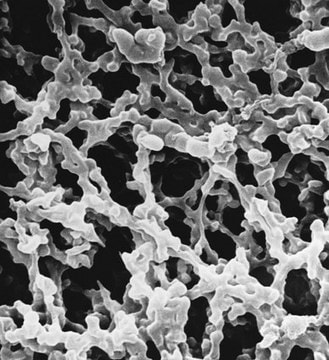1.12298
Triton™ X-100
for gas chromatography
Synonyme(s) :
Octoxynol, (p-tert-octylphénoxy)polyéthoxyéthanol, O-[4-(1,1,3,3-tétraméthylbutyl)phénoxy]polyéthoxyéthanol, polyéthylèneglycol-[4-(1,1,3,3-tétraméthylbutyl)phényl]-éther, t-Octylphénoxypolyéthoxyéthanol, Éther tert-octylphénylique du polyéthylène glycol
About This Item
Produits recommandés
Pression de vapeur
<0.01 hPa ( 20 °C)
Niveau de qualité
Forme
liquid
Puissance
1900-5000 mg/kg LD50, oral (Rat)
>3000 mg/kg LD50, skin (Rabbit)
Poids mol.
micellar avg mol wt 80,000
average mol wt 625
Nombre d'agrégation
100-155
Technique(s)
gas chromatography (GC): suitable
pH
5.0-8.0 (20 °C, 10 g/L in H2O)
CMC
0.2-0.9 mM (20-25°C)
Point d'ébullition
>200 °C/1013 hPa
Température de transition
flash point 251 °C
cloud point 65 °C
pour point ~7 °C
Densité
1.07 g/cm3 at 20 °C
HLB
13.5
Température de stockage
2-30°C
Chaîne SMILES
CC(C)(C)CC(C)(C)c1ccc(OCCOCCOCCOCCOCCOCCOCCO)cc1
InChI
1S/C28H50O8/c1-27(2,3)24-28(4,5)25-6-8-26(9-7-25)36-23-22-35-21-20-34-19-18-33-17-16-32-15-14-31-13-12-30-11-10-29/h6-9,29H,10-24H2,1-5H3
Clé InChI
HNLXNOZHXNSSPN-UHFFFAOYSA-N
Vous recherchez des produits similaires ? Visite Guide de comparaison des produits
Application
- Regression analysis for the determination of microplastics in sediments using differential scanning calorimetry.: This study utilized sea sand as a matrix to investigate the presence of microplastics in sediment samples through differential scanning calorimetry (Schirrmeister et al., 2024) (Schirrmeister et al., 2024).
- Combination of Sea Sand Disruption Method and Ion-Pair Solid-Phase Extraction for Effective Isolation and Purification of Chlorogenic Acid from Plants Prior to the HPLC Determination.: The research developed a novel method combining sea sand disruption and ion-pair solid-phase extraction to enhance the isolation and purification of chlorogenic acid from plant matrices (Wianowska, 2022) (Wianowska, 2022).
- Vortex-assisted matrix solid-phase dispersion: An eco-friendly alternative for the determination of halogens in edible seaweed.: Sea sand was employed in vortex-assisted matrix solid-phase dispersion, presenting an eco-friendly technique for analyzing halogens in seaweed (de Melo Malinowski et al., 2022) (de Melo Malinowski et al., 2022).
- Matrix solid phase dispersion-assisted BCR sequential extraction method for metal partitioning in surface estuarine sediments.: This study used sea sand in matrix solid-phase dispersion to improve the extraction and partitioning analysis of metals in estuarine sediments (Martínez-Fernández et al., 2011) (Martínez-Fernández et al., 2011).
Actions biochimiques/physiologiques
Remarque sur l'analyse
Constante de McReynolds (benzène) : 190 - 250
Constante de McReynolds (butanol) : 370 - 420
Constante de McReynolds (nitropropane) : 365 - 405
Stabilité en température : perte de poids entre 270 et 290 °C (thermogravimétrie) : ≤ 2 %
Eau (selon Karl Fischer) : ≤ 0,2
Informations légales
Mention d'avertissement
Danger
Mentions de danger
Conseils de prudence
Classification des risques
Acute Tox. 4 Oral - Aquatic Acute 1 - Aquatic Chronic 1 - Eye Dam. 1 - Skin Irrit. 2
Code de la classe de stockage
10 - Combustible liquids
Classe de danger pour l'eau (WGK)
WGK 3
Point d'éclair (°F)
483.8 °F - closed cup
Point d'éclair (°C)
251 °C - closed cup
Certificats d'analyse (COA)
Recherchez un Certificats d'analyse (COA) en saisissant le numéro de lot du produit. Les numéros de lot figurent sur l'étiquette du produit après les mots "Lot" ou "Batch".
Déjà en possession de ce produit ?
Retrouvez la documentation relative aux produits que vous avez récemment achetés dans la Bibliothèque de documents.
Les clients ont également consulté
Notre équipe de scientifiques dispose d'une expérience dans tous les secteurs de la recherche, notamment en sciences de la vie, science des matériaux, synthèse chimique, chromatographie, analyse et dans de nombreux autres domaines..
Contacter notre Service technique








